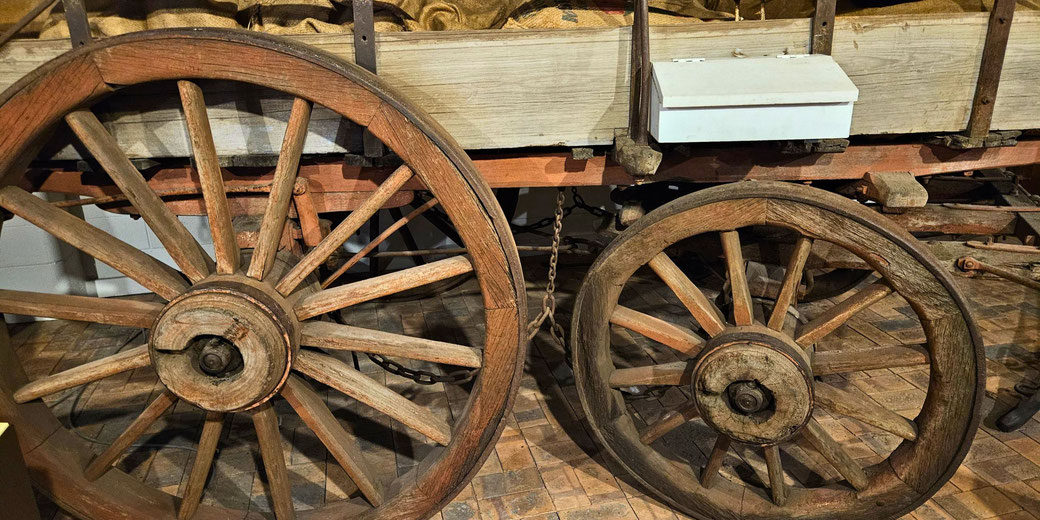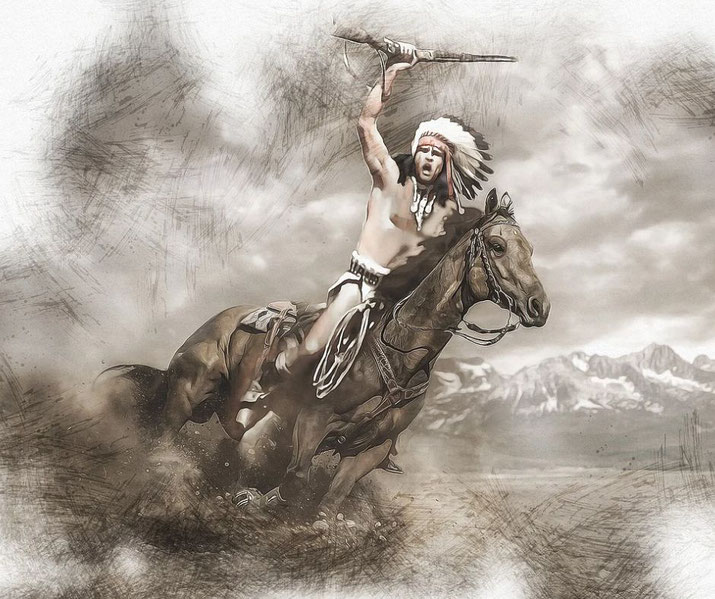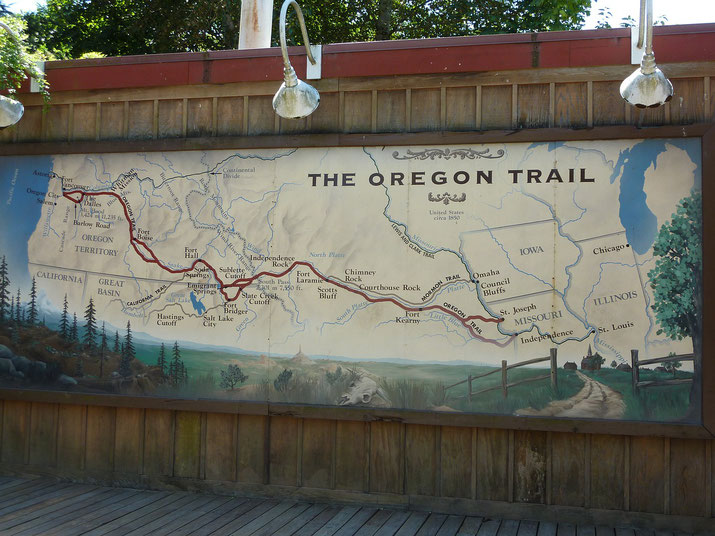From the Louisiana Purchase to the Oregon Trail: America's westward expansion

The gradual Westward expansion of European colonists during the 19th century transformed the United States from a fledgling nation on the Atlantic coast to a sprawling country stretching across North America.
This movement was driven both by ambition and the promise of new wealth-creation opportunities through the acquisition of vast new territories.
By the end of the 19th century, the frontier had vanished, and the dream of Manifest Destiny had become a reality.
The first stages of European colonisation
European colonists began the settlement of North America on the eastern coastline, since this was the closest to Europe.
The first British settlers didn't push inland until the 1630s, when the Massachusetts Bay colonists entered the Connecticut River valley.
By the mid-1700s the 13 American colonies had taken substantial tracts of land and had reached the Appalachian Mountains.
Following the French and Indian War, the British parliament released the Proclamation of 1763, which ordered that expansion should not continue beyond the Appalachians.
However, this was largely ignored, and colonists expanded into what is now Ohio, Tennessee, and Kentucky.
After the American colonies had won their independence from Britain at the end of the American Revolution, there was a renewed push to expand into the fertile lands between the Appalachians and the Mississippi River, and further westward.
However, it wasn't until the conclusion of the War of 1812 that this began in earnest.

Louisiana Purchase
The first major step in obtaining new lands in North America came in the early 19th century.
The French Empire under Napoleon was busy with a series of wars in Europe and desperately needed money.
The maintenance of French territories in North America was considered to be too costly and so the idea was proposed to sell France's colonies to the newly formed United States of America for a quick way to raise money.
So, in 1803, the United States agreed to the deal and acquired the Louisiana Territory from France for a cost of 50 million francs and the cancellation of debts which amounted to about 18 million francs.
This transaction is known as the 'Louisiana Purchase'.
These territories which the US gained stretched from New Orleans and the Gulf of Mexico in the south, through the plains to part of Canada in the north, and from the Mississippi River in the east and the Rocky Mountains in the west.
These new lands, which were around 828,000 square miles (2,144,520 square km) in size, effectively doubled the size of the United States of America at the time, and it opened up vast new territories for settlement.
However, before settlement could properly begin, the US government needed to know what was in these lands: the peoples, cultures, rivers, mountains, and natural resources.
To do this, they needed to arrange someone to explore and record the details.
The Lewis and Clark Expedition
The recently elected US President Thomas Jefferson commissioned Meriwether Lewis and William Clark to lead an expedition to explore the newly acquired Louisiana Territory.
The goal of the expedition was to find a route from the east coast to the Pacific Ocean. Jefferson hoped that an east-west river could be found that would make transport across the vast area easier.
Lewis and Clark and their group, known as the 'Corps of Discovery', set out in 1804. There were 40 men in their group, including one enslaved man called York.
They were to travel more than 8000 miles (almost 13,000 kms) over the course of two and a half years.
They sailed up the Missouri River, walked across the Rocky Mountains, then travelled down the Columbia River until they reached the Pacific Ocean.
They explored new territories, met with Native American tribes, and recorded valuable information about the land and resources of the West.
With their goals completed, they then turned back towards home.
The pair returned to the city of St. Louis on the 23rd of September 1806. They had gathered a significant amount of new information that would help guide further expansions efforts, as their notes revealed much about the geography and natural resources of the West.
They produced 140 maps and had made contact with over two dozen Indian nations. Eventually, the route they took would become part of the famous Oregon Trail.
Population of the new parts of the United States grew quickly following their journey.
The number of people living in the states of Mississippi and Louisiana doubled between 1810 and 1820.
Even more remarkably, Alabama's population grew twelve times its size in the same period.
Missouri Compromise
In 1819, the United States signed the Adams-Onís Treaty with Spain, in which Spain ceded Florida to the U.S. and established the boundary between U.S. and Spanish territories.
In the same year, the territory of Missouri officially applied to join the United States of America.
While the inclusion of new territories was usually welcome, as it meant greater economic and military security, there were genuine hesitations about Missouri's application.
The hesitation was caused by the fact that Missouri was a territory that allowed the ownership of slaves.
A debate began between American politicians about whether this fact should stop the state from joining the union.
During 1819, serious arguments broke out between politicians who supported slavery and those who opposed it.
Finally, an agreement was reached called the 'Missouri Compromise', which was then passed by Congress in 1820.
Under this agreement, it was decided that slave-owning states would be allowed to join the United States as long as a second state was allowed to join at the same time which did not allow slavery.
This requirement of accepting new territories in pairs (one slaveholding and one free) sounded like a clever way to avoid a difficult decision, but it would end up creating long-term divisions within American society.
In reality, this law established a dividing line between free state (mostly in the north) and slave states (mostly in the south), which would set the stage for the Civil War forty years later.
People in the northern states grew concerned about the use of slaves in the new territories because they feared that it would upset the balance in Congress.
A second compromise would be arranged thirty years later, in 1850, which attempted to address their concerns.
In what was called the Fugitive Slave Law, Congress ruled that people in the northern states had to help capture runaway slaves or be fined up to $1,000.
Also, the buying and selling of slaves were banned in the District of Columbia. Despite this second compromise, it ultimately failed to provide a real solution to the ongoing existence of slavery.
The Monroe Doctrine
In 1823, US President James Monroe issued a formal declaration known as the 'Monroe Doctrine'.
In this statement, the president declared that the United States would not accept any further European colonisation in the western hemisphere.
Essentially, this statement was a warning to European powers not to interfere in American expansion in North America, and signaled that the United States aimed to be the dominant power in the region.
When the Monroe Doctrine was announced, there was little America could do to enforce it.
Their armed forces were still relatively small in comparison to the land it sought to control.
However, what made this declaration important is that by the end of the 19th century, when the United States was a much larger and more impressive nation, people would look back on this declaration as a justification for America's own attempts at colonisation.
Indian Removal Acts
The continued acquisition of land and westward settlement by the Americans caused a sharp increase in conflict with the Indigenous inhabitant of the lands.
The Native Americans actively resisted the forced seizure of their lands by both state government forces and individuals acting on their own accord.
In an attempt to facilitate the settlement of the land, the US government created a series of acts to force the native peoples to leave their land.
President Andrew Jackson proposed that any remaining Native American peoples still living east of the Mississippi River were to be relocated west to parts of what would become Oklahoma.
In 1830, the Indian Removal Act was passed by Congress, which gave government troops the authority to enforce the relocations.
Since the Indigenous peoples could not match the technologically advanced weapons and military training of the forces arrayed against them, they had no choice but to comply with these new laws.
Some of the Native people did attempt to resist but were attacked by the soldiers and were used as a warning to other groups not to follow their examples.
The Cherokee nation took a different approach and took legal action against the state of Georgia in the Supreme Court.
Even though the Cherokee nation won their case, President Jackson ignored the decision and ordered their removal anyway.
Between the years of 1830-50, whole communities were removed and forced to walk long distances to poorly prepared reservations.
Even at the time, this policy was controversial, and it resulted in the 'Trail of Tears', a devastating journey that resulted in the death of thousands of Native Americans.
An estimated 50,000 people were removed from their traditional lands during this time.
Of these, somewhere between 3,000 to 12,000 of them died due to exhaustion, starvation, or exposure to the elements.
Oregon Trail
As new lands were opened up as a result of the removal of large Native American nations like the Cherokee, Creek, Choctaw, Chicasaw and Seminole, more Americas saw an opportunity to travel west and to settle.
To handle the influx of travellers westward, a number of key paths opened up. One of these became known as the Oregon Trail.
In 1841, the Oregon Trail was opened up to settlers. This trail allowed Americans to travel from Missouri to the Pacific Northwest by wagon.
It spanned about 2,000 miles (3,200 km), and from 1841 to the 1860s, hundreds of thousands of emigrants would travel along it to reach the north-west.
The journey along the Oregon Trail became famous for its dangers and for the hardships that settlers endured while traveling on it.
Despite the challenges, however, many Americans willingly faced them in the hopes of finding a better life and financial independence.
Mexican-American War
Ever since the Spanish conquest of the Aztec in the 16th century, the Spanish empire had slowly expanded into parts of North America.
The area that would become the state of Texas was first visited by the Spanish in the 1680s and 1690s, at which time it was claimed by the Spanish crown.
In 1810, the country of Mexico went to war with Spain to win its own independence.
As a result, Texas was considered to be part of Mexico when the war ended in 1821. However, there were already questions about how secure this region was.
Then, between 1835-6, the state of Texas had undergone its own revolution to separate itself from the country of Mexico.
While Texas had won this conflict and had created the Republic of Texas in 1836, Mexico refused to officially acknowledge it.
Then, in 1845, Texas applied to join the United States through annexation, which was accepted.
However, the ongoing tension with Mexico required diplomatic discussions between the two countries.
Specifically, the United States needed to know where the border between Texas and Mexico was: the Nueces River (as Mexico claimed) or the Rio Grande (which the US preferred).
US President James Polk not only wanted Texas to join the union, but also California, which was owned by Mexico.
He sent US troops, under command of General Zachary Taylor to the Rio Grande to provoke a war.
In April 1846, Polk told Congress that Taylor had been attacked by Mexican troops and, as a result, the US had declared war.
For the next two years, the American forces won most of the battles between the two sides and achieved a clear victory.
However, it was only after American troops marched into Mexico City that Mexico finally surrendered.
The war came to an end in 1848 with the Treaty of Guadalupe Hidalgo, which meant the acquisition of 500,000 square miles (1,300,000 square km) of Mexican territory, from the Rio Grande to the Pacific Ocean.
The new territories included the areas occupied by the modern states of California, Nevada, Utah, New Mexico, and most of Arizona and Colorado.
Manifest Destiny
Towards the end of the Mexican-American War, and the significant land gains the US would receive at its culmination, the United States of America seemed to have achieved the unthinkable.
In the space of about 40 years, it had managed to take control of most of the continent of North America (not including Canada).
At this point, a certain confidence and arrogance appeared to develop in the American mind about the achievements behind this 'miracle'.
This was the result of a religious belief in the control of history by God.
To many Americans, the rapid expansion of America since the Revolutionary War seemed to show that God had ordained a special destiny for the country and had made it a reality (or "made it manifest" as they would have said).
The phrase "Manifest Destiny" was developed to describe this idea, and it was coined by American journalist John O’Sullivan in 1845.
Embedded within this concept was the belief that America and its government were clearly superior to all other cultures and, as a result, they should spread these institutions around the world in order to free people from other, inferior, ideologies.
The concept of Manifest Destiny played a major role in encouraging further settlers to move westward.
People came to believe that it was their duty to spread democracy and Christianity throughout the continent.
California Gold Rush
Almost as a confirmation of these beliefs, a miraculous discovery in the west dramatically changed the economic hopes of the United States.
In 1848, gold was discovered in California, and it appeared that there was a significant amount of it.
All that was required for people to get suddenly rich from these deposits was to simply travel to California, and, with a pick and shovel, dig up the free gold.
News of the discovery triggered a fevered influx of new people, from both the eastern side of America and from around the world.
Thousands of settlers descended on the region and vast mining camps sprang up from San Francisco to the mountains to the east.
As predicted, huge quantities of gold were dug up and some people became instantly wealthy.
However, within a few months, most of the easiest gold had been taken, and people had to start digging deeper to find more.
Quickly, the opportunities for instant wealth became rarer, and most people spent a lot of their time on the gold fields and did not find anything.
However, the Gold Rush was an important event because it helped to spur economic development in California, and it transformed the West Coast into a major center of commerce and industry.
The dramatic increase in the population sizes of cities in the western states helped create much stronger state systems.
Further reading
What do you need help with?
Download ready-to-use digital learning resources
Copyright © History Skills 2014-2025.
Contact via email
With the exception of links to external sites, some historical sources and extracts from specific publications, all content on this website is copyrighted by History Skills. This content may not be copied, republished or redistributed without written permission from the website creator. Please use the Contact page to obtain relevant permission.






